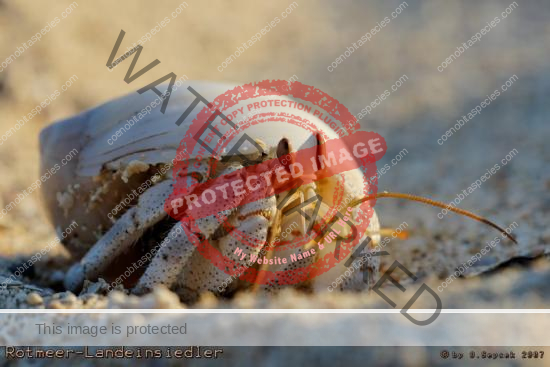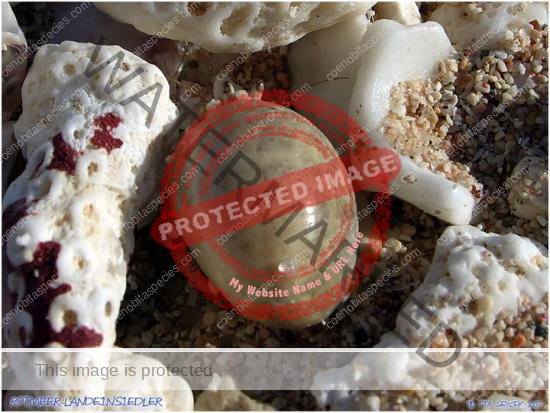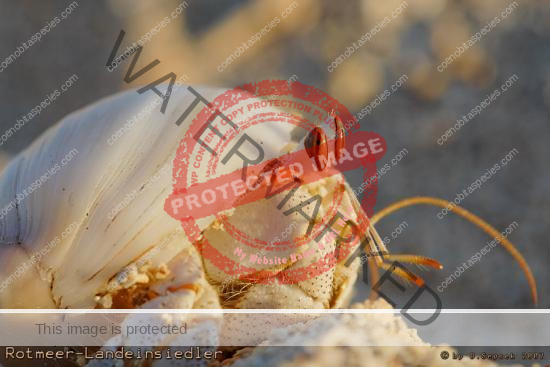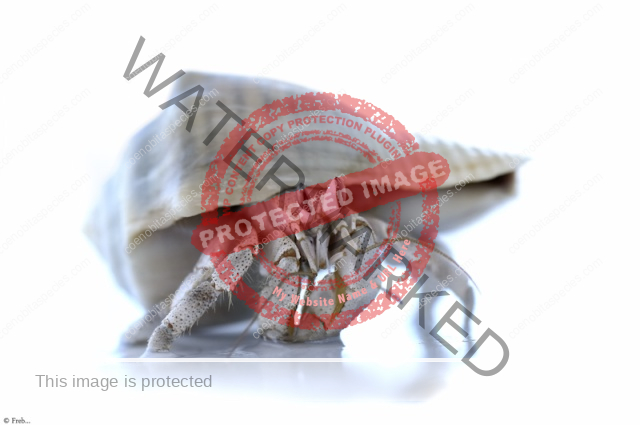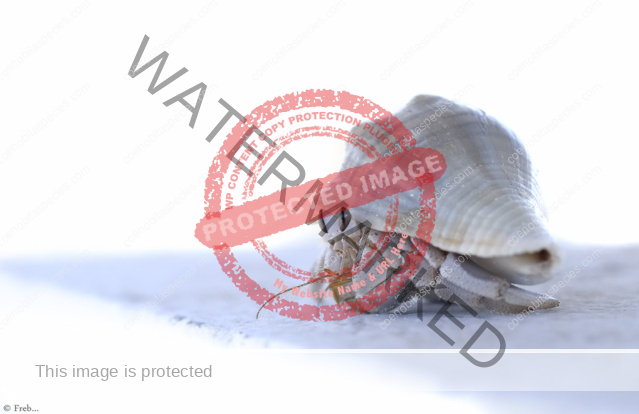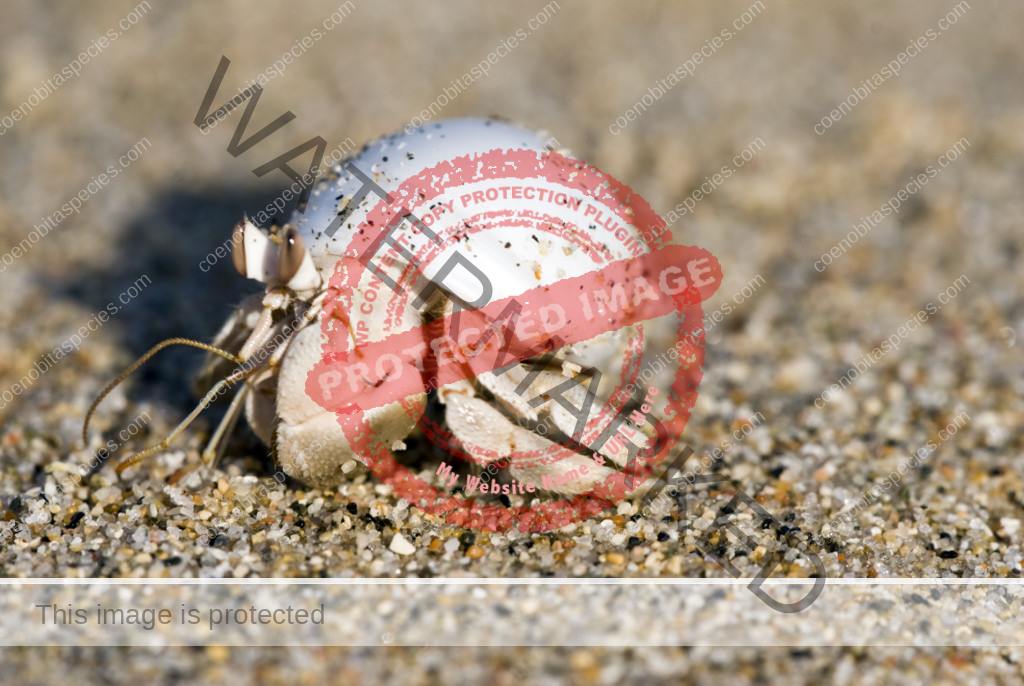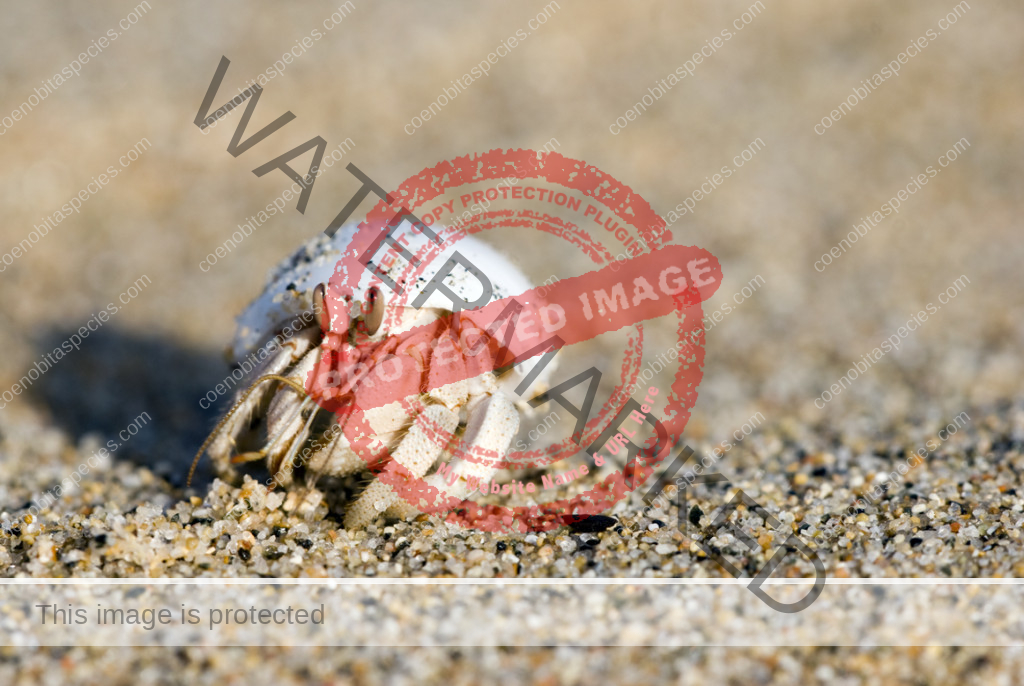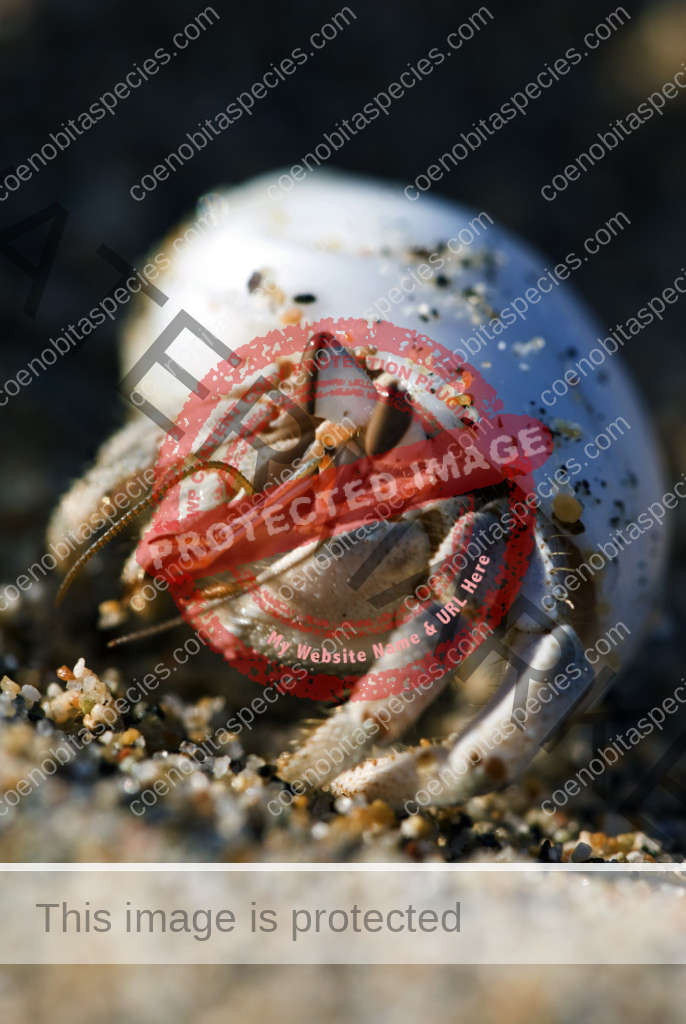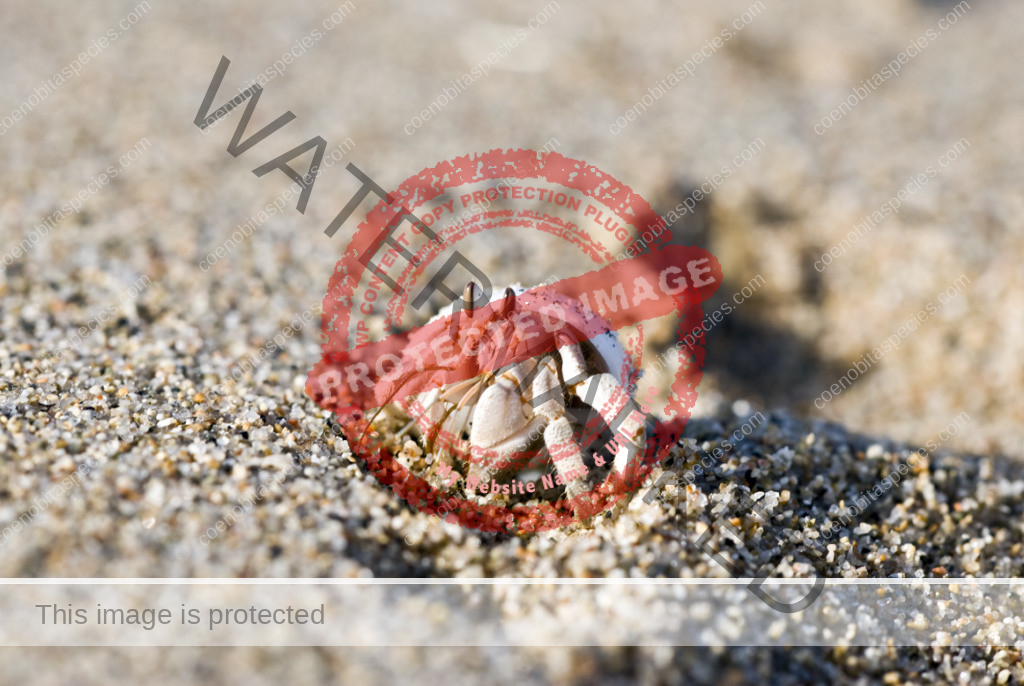
Common Name: Red sea crab
Latin Origins: Scaevola or Scævola= left-handed
Distribution: Coenobita scaevola lives around parts of the Indian Ocean, including the Gulf of Aden and the coasts of Somalia and Pakistan.[2] Although the hermit crabs of the Red Sea are poorly studied,[3] they include C. scaevola as the region’s only species of terrestrial hermit crab.[2][4] Larak Island, Iran [10] Gulf of Oman, Iran, Persian Gulf [11]
Habitat: Coenobita scaevola can survive in arid conditions, such as those on the Sinai Peninsula, but only close to the shore, to which it must return regularly to replenish the water stored in its shell for respiration.[6][2] Although the air temperature outside the burrows can reach 33 °C (91 °F) during the day, at a depth of 10 cm (3.9 in), the temperature does not exceed 28 °C (82 °F).[7] Larak Island, Persian Gulf, Iran [10] Supralittoral zone of sandy beaches. They hide themselves in aggregations under moist sand often at shadow of the cliffs in the daytime. [11] Humidity is low due to dominant north winds blowing from the desert. Rain is rare and mean annual precipitation is only 17mm. There are no rivers or fresh-water sources along the Sinai Peninsual coasts. No bush or dense vegetation is found along the coast of Sinai, except for the mangal regions. [13]
Adult scaevola travel further from shore than juveniles who rarely leave the shore. Beach dweller.
Larval stages:
Reproduction takes place during the hottest months of the year, when temperatures are 24–38 °C (75–100 °F).[6] In common with other hermit crabs, the young animals of Coenobita scaevola pass through a number of larval phases,[4] before reaching the glaucothoe and then the juvenile stage. C. scaevola has the greatest number of zoeal phases of any Coenobita species (seven), and they last longer than in any other Coenobita species, lasting a total of 54–80 days.[6]
Ecology: C. scaevola rests in burrows or among coastal vegetation during the heat of the day, and emerges at night to feed.[6] The shelter never exceeded 30 m from the high water line. After emerging from their day refuge they went to the seat to fill their shells.[13]
Summary [9]
The terrestrial hermit crab Coenobita scaevola is very common on the coast of the Red Sea. The species depends on the sea for its source of food (wrack-fauna), source of drinking-water and water for moistening gills and abdomen. Only in the supra-litoral zone they find gastropod shells to protect their abdomen against insolation, desiccation and mechanical damage.
Coenobita scaevola stays in one place for a long time if good living conditions are available. The time of activity of the juveniles differs from one place to another. Some are diurnal, others are nocturnal. There is no evident relation to the ecological factors. Most of the adults are nocturnal. No Coenobita could be collected in Barber traps. The avoidance of such traps by arthropodes has never been observed before.
Coenobita scaevola can live for quite a long time under water of sufficient temperature and salinity. The osmotic regulation of the land-hermit crab differs from that of other shore animals. Coenobita can tolerate a wide range of blood concentrations (25–70‰). It controls the concentration of its blood by selecting water of the appropriate salinity.
The static problems of Coenobita are solved by regular movement of the legs and special articulation of the legs.
As Coenobita scaevola is a phylogenetically young land animal it carries many inhabitants of marine and terrestrial origin.
Characteristics:
Sexual size dimorphism was observed in C. scaevola, where males attained larger sizes than females. Ovigerous females may show a cryptic habit during daylight and active at night, a common occurence among ovigerous females of crustaceans.[8]
Common identifiers:
Eyes – elongated stalks, the eye is like obsidian (shiny black)
Large claw – stitch marks
Coloring – white or pale pink
Chirps – it is now believed that all species are capable of producing sound but some may be more readily vocal than others. [14]
Behavior:
Diet: omniverous scavengers [11]
Preferred shells:
Most adults up to a carapace length of 7.5 mm (0.30 in) occupy a Nerita undata shell. Larger individuals choose Turbo radiatus, Polinices milanstomus and Monodonta canalifera, while small individuals (below 3 mm or 0.12 in) occupy shells of Planaxis sulcatus and Nassarius arcularius.
In the protected area of Wad El-Gemal, Red Sea the preferred shell is also Nerita undata followed by Turbo radiatus. Additionally in this area, Littorina scabra, Mondodonta canilifera and Nassaruis arcularius plicastus were occupied only by males. Other shells worn include: Cerithium caeruleum, Nassarius protrusidens, Natica gualteriana, Polinices milanstomus.[8] Juveniles and small adults: Nerita spp., Nerita sp., Policies sp., Turritella sp., Bufunaria sp. In large adult crabs: Turbo sp., Hexaplex sp., Thais spp., Babylonia sp., Rapana sp. [11]
![Coenobita scaevola [12]](https://coenobitaspecies.com/wp-content/uploads/2015/03/scaevola.png)
![Coenobita scaevola [11]](https://coenobitaspecies.com/wp-content/uploads/2015/03/scaevola_littoralcrabsofgulfomaniran.png)
C. scaevola on Instagram
[insta-gallery id=”10″]
Photo Credits:
The Crab Street Journal has been granted permission by these photographers to use their photo(s) on our site.
References:
1. Patsy McLaughlin (2010). R. Lemaitre & P. McLaughlin, ed. “Coenobita scaevola (Forskål, 1775)”. World Paguroidea & Lomisoidea database. World Register of Marine Species. Retrieved January 5, 2012.
2. Richard G. Hartnoll (1988). “Evolution, systematics, and geographical distribution”. In Warren W. Burggren & Brian Robert McMahon. Biology of the Land Crabs. Cambridge University Press. pp. 6–54. ISBN 9780521306904.
3. Khaleid F. Abd El-Wakeil, Elham S. Ahme, Ahmad H. Obuid-Allah & Nasser A. El-Shimy (2009). “Hermit crabs (Crustacea: Decapoda: Anomura) inhabiting the intertidal and shallow subtidal region of Red Sea coast of Egypt” (PDF excerpt). Zootaxa 2213: 57–63.
4. Ali Al-Aidaroosa & D. I. Williamson (1989). “Larval development of the land hermit crab Coenobita scaevola (Forskål, 1775) (Crustacea: Anomura: Coenobitidae) reared in the laboratory”. Journal of Natural History 23 (1): 111–128. doi:10.1080/00222938900770071.
5. Peter Forsskål (1775). “Cancer”. Descriptiones animalium avium, amphibiorum, piscium, insectorum, vermium (in Latin). Copenhagen: Möller. p. 93.
6. Wafaa S. Sallam & Fernando L. Mantelatto (2010). “Population features and breeding season of the land hermit crab Coenobita scaevola (Forskäl, 1775) (Anomura, Coenobitidae) from Wadi El-Gemal, South Red Sea, Egypt” (PDF). Nauplius 18 (1): 25–33.
7. Colin Little (1983). “Crustaceans and the evolution of the arthropods“. The Colonisation of Land: Origins and Adaptations of Terrestrial Animals. Cambridge University Press. pp. 63–105. ISBN 9780521252188.
8. W. S. Sallam, F. L. Mantelfatto & M. H. Hanafy (2008). “Shell utilization by the land hermit crab Coenobita scaevola (Anomura, Coenobitidae) from Wadi El-Gemal, Red Sea” (PDF). Belgian Journal of Zoology 138 (1): 13–19.
9. Zur Biologie und Ökologie des Landeinsiedlerkrebses Coenobita scaevola Forskål am Roten Meer
10. Littoral hermit crabs of Larak Island, Persian Gulf, Iran
11. Littoral hermit crabs from the Gulf of Oman, Iran M. Moradmand and Alireza Sari
12. Some ecological aspects of the land hermit crab Coenobita scaevola (Coenobitidae) at Wadi El-Gemal protected area, Red Sea Abd Al-Kader M. Hassan , Besar, M.H. , Hanafy MH and Mohamed M. Abu-Zaid
13. Adaptation of Coenobita scaevola (Forskal) to terrestrial life in the desert-bordered shore line Y. Achituv & M. Ziskind
14. Sound production in the lhc C purpureus Imafuki, M., Ikeda, H.

